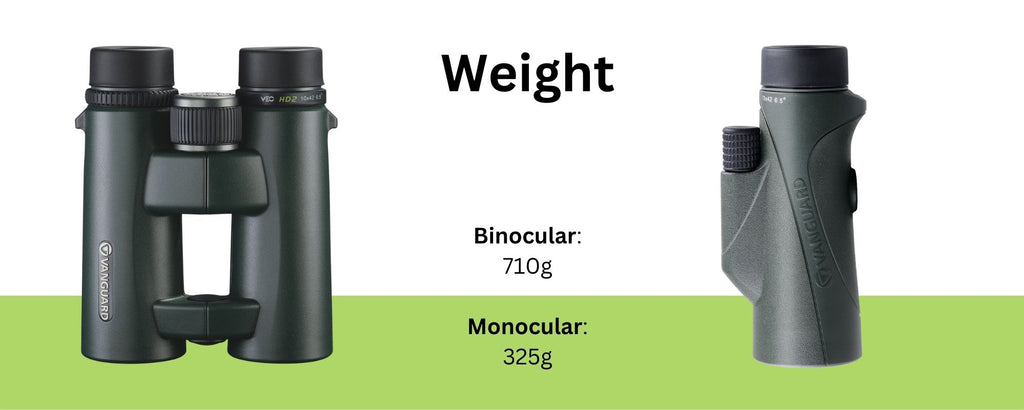Whether you're an experienced binocularphile needing new optics, or you're starting out in a hobby that needs optics to get closer to the action, it's easy to overlook a monocular.
Here we share six reasons why you may prefer a monocular by comparing the VEO HD2 10x42 binoculars with the VEO HD2 10x42 monocular.
In the optics they are pretty much identical, though the binoculars clearly have two barrels. Both include HOYA ED glass with BaK4 roof prism(s), and both deliver a 6.5° viewing angle and relative brightness. As a result, the key differences are in the use of each model.

Even folded, a pair of binoculars is much more bulky and it's unlikely you'll be able to slip a pair of binoculars into even the largest pocket with ease, let alone taking it out. At around 1/2 the size, monoculars are much more streamlined and are easier to keep to hand as you travel, whether in a jacket pocket, a laptop bag or the glove compartment of your car, making them easier to keep to hand for those unexpected sightings.

As they only have one barrel and no need for the associated connections, monoculars are generally less than 1/2 the weight of a pair of binoculars. This makes them more portable, but also makes them easier to use over extended periods with a wrist strap. To maximise portability, you may want to consider a quick release wrist strap that can be attached/removed in seconds, such as a VEO Optic Guard Wrist Strap.

To focus a pair of binoculars, you need to focus each barrel separately using the dioptre wheel. This ensures the best optical performance, and using both eyes will give you a better 3D perspective of your subject than a monocular. However, even a lockable dioptre can be knocked as you go, meaning it has to be reset and could lead to missing a fleeting subject. The need for the dioptre also makes it harder to share a pair of binoculars as the dioptre would need to be reset every time you swapped binoculars.
A monocular on the other hand only needs to focus for one eye, making it fast to focus and easy to share.

If you're planning to use your optics in one place over extended periods, or need stability for digiscoping, then we'd always recommend using a tripod, monopod or hide clamp.
All Vanguard monoculars include a 1/4" thread on the base so can attach to any quick release plate, or directly onto a suitable monopod/tripod (please note, not all monocular brands feature this, so if this feature is important, always check before you buy as it can't be sorted out by an accessory).
To do the same with a pair of binoculars would require an adaptor like the BA-185. It's not expensive, but it is another cost, and it's something that's easy to forget or lose which can take away from the enjoyment of your trip.

Digiscoping is a great way to capture a sighting without the need for a separate camera and expensive lens (you can read our guide to digiscoping here).
Our Vanguard monoculars include a digiscope adaptor and Bluetooth remote control for IOS and Android as standard. Just pair the remote control and attach your smartphone (up to 87mm wide) and your ready to go. To do this using a pair of binoculars will involve buying a suitable digiscope adaptor such as the VEO PA-62 Universal Digiscope Adaptor for eyepieces between 41.mm and 45mm, and smartphones up to 90mm wide.
While we'd always recommend a support for the best results, the lighter design and ease of getting to the focus wheel makes it easier to digiscope by hand with a monocular.

As you're removing a barrel, you're not just halving the materials, but also removing complexity from the design as you don't need to attach the two barrels and set them up to focus independently. This allows Vanguard to add value by including the digiscope adaptor and Bluetooth remote control, while still delivering a monocular that's often around 1/2 the price of a pair of binoculars. This gives you the choice of saving a little cash, or trading up on the optical performance.

At Vanguard we offer a choice of three monoculars:
The VESTA 8230M is our starter model with 8x magnification and a 32mm objective lens. Weighing just 260g and measuring just 127 x 47 x 70mm, it's also our most portable.
The VEO ED 8420M introduces Extra Low Dispersion (ED) glass in a model with 8x magnification and a 42mm objective lens. The 42mm objective lens and the ED glass allow in more light for a brighter image.
The VEO HD2 1042M introduces HOYA Extra Low Dispersion (ED) glass in a model with 10x magnification and a 42mm objective lens. The 10x magnification gets you closer to the action, while the improved HOYA ED glass maximises the quality of light that reaches your eye.
All these models include a wrist strap, carry case, thread for a 1/4" screw, a digiscope adaptor and a Bluetooth remote control for IOS and Android.

It is subjective, but used properly, a pair of binoculars will deliver a better optical image. It feels a bit more alive and natural as you're able to use both eyes.
However, the optical image on a monocular isn't going to be that far away from the binoculars, and there are advantages for using the monocular. These can be summarised as portability (you're more likely to have your monocular to hand than your binoculars as they can be kept in your jacket pocket), simplicity (it's easier to hold, focus and share than a pair of binoculars) and value for money (allowing you to save some cash or upgrade your optical performance).
As a result, whether your that binocularphile or a starter, don't write off the option of a monocular from the start.

